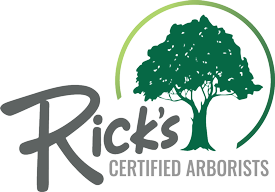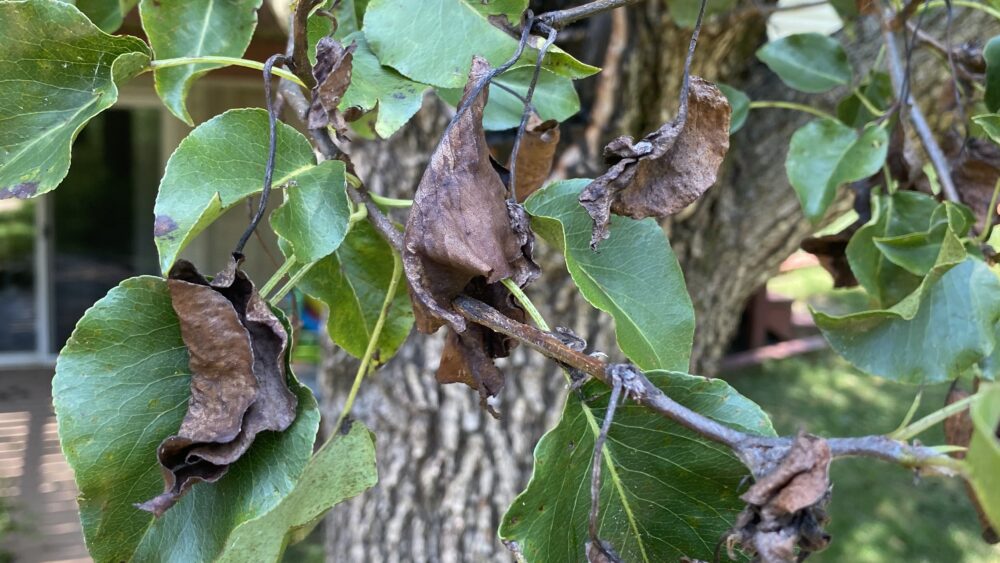Many homeowners enjoy ornamental Pear trees and their spring blossoms. However, these trees are vulnerable to a fungal disease called Pear Trellis Rust. Call Rick’s PHC Certified Arborists at 610-840-2655 to determine whether your Pear trees might be affected by this disease.
What is Pear Trellis Rust?
The fungus Gymnosporangium sabinae causes Pear Trellis Rust. The disease arrived in the United States from Europe in the 1990s and has caused a great deal of damage to ornamental Pears.
Pear Trellis Rust is a dual-host fungus that requires a Juniper to complete its life cycle. If you have Pears and Junipers, you should watch carefully for the symptoms of this disease.
Symptoms
Most homeowners notice the first symptom of Pear Trellis Rust is that the Pear trees begin dropping their leaves in the middle of the growing season. Examining the leaves shows red, yellow, and orange spots.
Later in the summer, brown “trellis”-like fruiting structures appear on the undersides of the Pear leaves, giving the disease its name.
Pear Trellis Rust can cause defoliation severe enough to weaken the tree. Repeated bouts with the disease could kill the tree.
Pear Trellis Rust can also affect twigs and fruit. Fruit may become mummified and fall early.
Treatment
Fungicide applied as a foliar spray and as a trunk injection can successfully treat Pear Trellis Rust. Fungicides approved for Pear rusts can be employed.
On Junipers, pruning infected branches is the best course of action.
Prevention
Since Pear Trellis Rust requires a Juniper to grow, removing Junipers from a 1,000-foot radius of the Pear tree should help. Avoiding planting Junipers will prevent the disease from affecting your Pear trees. Check your neighbors’ property as well as your own for this evergreen.
Are You a Good Candidate for Pear Trellis Rust Treatment?
Pear trellis rust is largely treatable but can be devastating if left to run its course. If you have Pear trees and any Junipers nearby, you need to watch this disease closely. If your Pear trees show any signs of Pear Trellis Rust, you should consider treating them before the infection spreads.
Why Choose Rick’s PHC Certified Arborists?
Our Certified Arborists expertly diagnose and treat tree health issues like fungal and bacterial infections and insect problems. We can handle complex infections like Pear Trellis Rust and other serious conditions. Our comprehensive services will allow you to maintain a healthy and beautiful landscape for your friends and family to enjoy.
Frequently Asked Questions About Pear Trellis Rust
Here are several client questions about this disease:
Why does Pear Trellis Rust only appear when there is a Juniper nearby?
The fungus that causes Pear Trellis Rust has two hosts: Pears and Junipers. The disease overwinters on the Juniper stems and spreads to the Pears in the spring using fungal spores. The Juniper develops galls (branch swellings) where the spores grow.
What does Pear Trellis Rust look like on a Juniper?
If your Juniper has Pear Trellis Rust, you will notice brown swellings about 1/5 inch long on the stems in the spring. When it is rainy or damp, you will see jelly-like orange masses of spores.
If I have Pears and Junipers, is there a way to keep them both?
While the best way of protecting your Pear trees against Pear Trellis Rust is to remove all Junipers from the area, there are steps you can take to help the plants coexist safely. You can carefully prune your Junipers, disposing of the infected material. Practice good hygiene around your trees and pick up all fallen Pear leaves during the summer.
Alternatively, you can plant rust-resistant Juniper varieties like Juniperus horizontalis, J. communis, and J. squamata.
Is the disease equally dangerous to Junipers and Pears?
Junipers usually do not receive major damage from Pear Trellis Rust infection. With careful pruning, Certified Arborists should be able to save them.
Does Pear Trellis Rust affect fruiting Pears as well as ornamental varieties?
The disease does not present as much of a problem to fruiting varieties as it does to ornamentals, though it can impact both.
Call Rick’s PHC Certified Arborists
If you have noticed leaf spots or defoliation on your Pear trees, don’t wait to treat them. Your Pear trees’ survival could depend on addressing the problem quickly. Call Rick’s PHC Certified Arborists at 610-840-2655 to learn more about Pear Trellis Rust and discover how you can combat this disease.


Comments are closed.